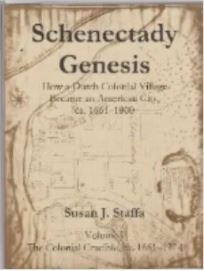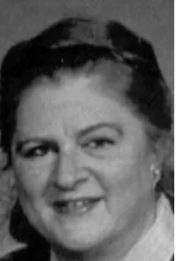| “Schenectady, the first town to be settled in the Mohawk Valley west of Albany, has long been aware of its Dutch origins. Local historians refer to the town as “Old Dorp”, while the city dubs “Patroons”, those upon whom it wishes to confer honor. The Schenectady County Historical Society has perhaps the most complete genealogical file in upstate New York, on the Abeels through the Ysselsteyns, as well as a fine collection of antiques representing the material culture of the Dutch. Recently however, the realization has dawned that the Dutch heritage is far more than the clay pipes and delftware of the Historical Society, the steep roofs of the Stockade, and the genealogy of a few residents. It is especially exciting that this awareness comes just when the city is passing through a period of economic transition and reaching for a new identity. In the expression of Schenectady’s Dutch past, it may find resources for the future.
Conceptually, Schenectady Genesis points in two directions. It refers not only to how Schenectady came to be, but the impact that Schenectady and the activities of Schenectadians had on the development of New York and the nation. The story of how the Dutch colonial village became an American city is part of the story of how the colonial Province of New York became a State, and European colonies in America became the United States. Schenectady’s story cannot be told properly apart from the stories Albany County and the Mohawk Valley in particular. A community’s political, economy, and cultural connections to the world outside are essential to its process of development, and it is only the larger context, by providing spatial and temporal perspective, that preserves local history from the realm of trivia and reveals the true significance of events. This book is the firs part of a two-part study that will trace the evolution of the Dutch colonial village of Schenectady, first into an English colonial borough town, and then into an American city incorporated in 1798. The aims of this work are several. I am writing primarily for general readers who may have heard of New York’s heritage do not perceive the connection between it and the modern Empire State. The heritage has no significance unless the connection is understood. Recent scholarly works have traced the evolution of Dutch colonial communities through the early part of the eighteenth century, but none has yet traced in detail the history of a single community all the way through the Revolutionary period and the last years of the 18th century. While scholars working in New York history will be interested to see a detailed study that covers a period of 137 years of the evolution of a frontier village community founded by the Dutch, Schenectady readers in particular will appreciate being able to relate local historical sites, structures, personalities, and traditions to broad themes of American cultural development in the colonial and post-colonial days of nation building. Dr. Susan J. Staffa |
 Schenectady Genesis How a Dutch Colonial Village Became an American City ca 1661 – 1800, Volume 1: The Colonial Crucible, ca. 1661 – 1774, Schenectady Genesis How a Dutch Colonial Village Became an American City ca 1661 – 1800, Volume 1: The Colonial Crucible, ca. 1661 – 1774, |
|
|
Here are but a few of the many comments we received regarding Genesis 1:
|
About the author….
A 1954 graduate of Nott Terrace HS, Dr. Staffa earned her AB from Vassar, her MA in education from SUNY, Albany, and her PhD in cultural anthropology from Indiana University. Her work included Curatorial Assistant, NY State Museum; Fellow of the American Research Center in Egypt; Assistant Professor of Anthropology, American University in Cairo, Egypt. During her years in Egypt she wrote Conquest and Fusion (Brill, 1977), tracing more than ten centuries of the social evolution of Cairo.
Returning to the US in 1975, she became the third generation of her family to own 32 Front Street, Schenectady’s Stockade, where she had grown up and the area that became NY State’s first historic district. Rekindled curiosity took Dr. Staffa into years of diligent research on Schenectady resulting in scores of newspaper and magazine articles, many lectures, radio and TV interviews, publication of Colonial Schenectady in Maps, and the founding of the Colonial Schenectady Project, Ltd., to work at putting Schenectady’s past at the service of its future, and the creation of The Historic Stockade: A Walking Tour with its audio counterpart Colonial Schenectady: An American Crucible, a multi-media self-guided tour of the Stockade District. Sadly, Dr. Staffa died left as her legacy her groundbreaking history writing Schenectady Genesis: How a Dutch Colonial Village Became an American City ca 1661 – 1800, Volume 1: The Colonial Crucible, ca. 1661 – 1774

